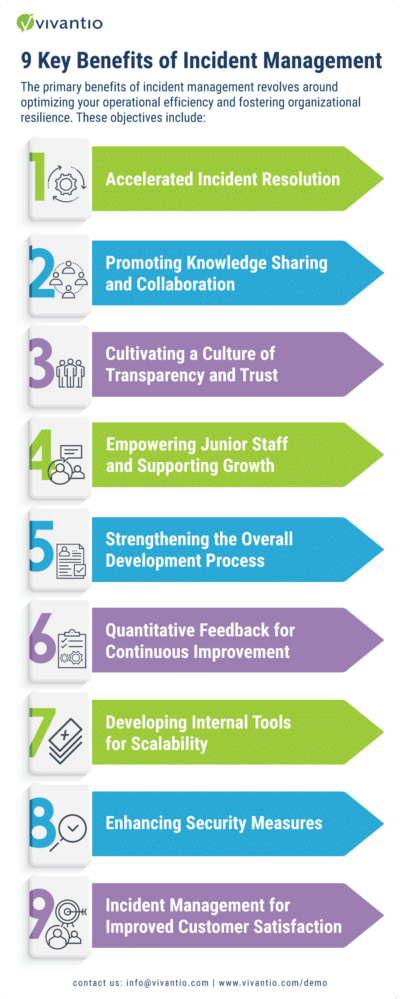9 Incident Management Benefits: Maximizing Efficiency and Resilience
Introduction
Things you will learn in this article:
- Nine key benefits of Incident Management
- Fostering beneficial outcomes through Incident Management Objectives
- Typical roles within an Incident Management Team
In this era of exponential information technology expansion, the ever-escalating demands placed on modern businesses raise a fundamental question: Amidst this unprecedented growth in the IT sector, how can organizations benefit from incident management to support their operations effectively?
With technology’s increasing complexity, we understand incidents are bound to occur. These incidents, whether they are system downtimes, security breaches, or service disruptions, can have a significant impact on your organization’s efficiency and customer satisfaction. This is where incident management steps in as a proactive and strategic approach to handling these challenges.
What is Incident Management?
Incident management stands as a structured approach to recognizing, addressing, and effectively resolving incidents, all while prioritizing minimal downtime, fostering transparent operations, and cultivating organizational growth. It goes beyond mere reactivity to issues, emphasizing proactive measures to tackle current problems, avert future recurrences, and perpetually enhance operational workflows.
9 Key Benefits of Incident Management
The primary benefits of incident management revolves around optimizing your operational efficiency and fostering organizational resilience. These objectives include:
1. Accelerated Incident Resolution
Incident management focuses on swift issue resolution. For instance, if a critical application crashes, every minute of downtime can lead to financial losses and damage to your brand’s reputation. By addressing incidents promptly, you can minimize these negative consequences.
2. Promoting Knowledge Sharing and Collaboration
Well-executed incident management encourages cross-training and collaboration among IT teams. When a service disruption occurs, it’s an opportunity for your team members to work together, share knowledge, and collectively solve the problem. This collaboration not only speeds up issue resolution but also enhances your team’s skills.
3. Cultivating a Culture of Transparency and Trust
Incident management ensures transparency by keeping all your business’s stakeholders informed about ongoing issues and resolutions. This transparency fosters trust between IT teams, management, and your customers, which, as we know, is essential for your long-term success.
4. Empowering Junior Staff and Supporting Growth
Effective incident management empowers your junior staff members by involving them in the resolution process. It provides an excellent learning opportunity, allowing them to gain hands-on experience and build their skills. This empowerment supports the growth of your team and organization.
5. Strengthening the Overall Development Process
Incident management goes beyond issue resolution. It involves analyzing the root causes of incidents, which can reveal weaknesses in your systems or processes. By identifying and addressing these weaknesses, you can strengthen your overall development process.
6. Quantitative Feedback for Continuous Improvement
Through incident management, you can gather quantitative feedback on incidents, including their frequency and impact. This data-driven approach enables continuous improvement, helping you identify recurring issues and implement preventive measures.
7. Developing Internal Tools for Scalability
As your organization grows, so do its IT needs. Incident management helps you develop internal tools and resources that can scale with your business, ensuring you’re prepared for future challenges.
8. Enhancing Security Measures
Incident management plays a crucial role in bolstering your organization’s security. It involves identifying and responding to security incidents promptly, mitigating potential data breaches, and safeguarding sensitive information. By integrating security into your incident management process, you fortify your defenses and reduce the risk of cyber threats, ultimately preserving your brand’s integrity and trustworthiness.
9. Incident Management for Improved Customer Satisfaction
Ultimately, the goal of incident management is to enhance customer satisfaction. By resolving incidents swiftly, maintaining open communication, and continuously improving services, you can ensure your customers receive the best experience possible.

Fostering Beneficial Outcomes through Incident Management Objectives
As you work to fortify your incident management, establishing primary objectives plays a pivotal role in achieving favorable outcomes. These objectives form the structured framework that will guide your organization towards efficiently addressing incidents and optimizing your operational resilience.
Objectives of Incident Management
- Swift Service Restoration: The foremost objective of incident management is to swiftly re-establish services to normal operation. By minimizing downtime, organizations can mitigate financial losses and uphold their brand’s reputation.
- Effective Incident Prioritization: Incident management involves prioritizing incidents based on their impact and urgency, ensuring that critical issues receive immediate attention while others are systematically addressed.
- Enhanced Incident Visibility: To prevent incidents from going unnoticed, incident management aims to enhance incident visibility. This includes robust incident tracking and reporting mechanisms.
- Efficient Response Methods The right methods are crucial for efficient incident response. Incident management frameworks provide guidelines for responding effectively, analyzing incident reports, and identifying areas for improvement to enhance the overall customer experience.
- Customer-Centric Resolution: Quick incident resolution is a central objective, directly contributing to increased customer satisfaction. Timely issue resolution reflects positively on an organization’s commitment to customer service.
- Operational Smoothness: Incident management ensures that operations continue to run smoothly by promptly addressing and resolving any issues that may arise. This proactive approach maintains operational integrity.
In the lifecycle of an application, significant effort is invested during its development, testing, and production phases. While the development team dedicates time to building features, the operations team assumes responsibility for ensuring the application’s seamless operation. Often, valuable feedback for improvement remains unaddressed and undiscovered.
This is where an incident management process steps in, serving as a catalyst for your application enhancement and an improved customer experience. By aligning incident management objectives with your organization’s goals, you’ll be able to navigate incidents with precision and resilience.
Incident Management Team – The Who & Why
Your incident management team plays a vital role in orchestrating seamless coordination among team members and resources. Their overarching goal is to mitigate disruptions to business operations and expedite service restoration, encompassing a wide range of incidents. Their pivotal functions include efficient responses, continuous improvement efforts, and the vital support they receive from your executive leadership.
The incident management team typically consists of a diverse group of individuals with specific roles and responsibilities to effectively respond to and manage incidents. The composition of the team may vary depending on your organization’s size, industry, and specific needs. However, here are some common roles you might find on an incident management team:
- Incident Manager: This is typically the leader of the team, responsible for overall incident coordination, decision-making, and communication with stakeholders.
- Technical Experts: These individuals possess expertise in the technical aspects related to the incident, such as IT specialists, cybersecurity experts, or system administrators.
- Communications Coordinator: Responsible for managing internal and external communications during an incident, including notifying relevant parties and providing updates.
- Legal and Compliance Experts: Ensure that incident response actions are in compliance with legal and regulatory requirements.
- Public Relations/Spokesperson: Handles external communications, especially when incidents may affect your organization’s public image.
- Customer Support Representatives: If the incident impacts customers, having dedicated support staff to address customer inquiries and concerns is crucial.
- Operations and Infrastructure Team: Those responsible for maintaining and restoring affected systems and services.
- Data Analysts: Analyze data related to the incident to understand its scope, impact, and potential vulnerabilities.
- Human Resources: Can assist with internal communication, especially for incidents involving employees or workplace issues.
- Quality Assurance and Testing: Ensure that systems are thoroughly tested and validated before returning to normal operation.
- Incident Documentation and Reporting: Keep records of incident details, actions taken, and outcomes for post-incident analysis and reporting.
The specific roles and responsibilities may be adapted to suit your organization’s needs, and cross-functional collaboration is crucial for a successful incident management team.
Realizing the Benefits of Incident Management
In the rapidly evolving landscape of information technology, organizations face increasing demands that necessitate a robust and meticulously structured infrastructure. Incident management, with its array of benefits, emerges as a proactive and strategic solution to support efficient operations and bolster resilience.
Establishing clear incident management objectives forms the structured framework that will guide your organization in addressing incidents with precision and resilience. Swift service restoration, effective prioritization, enhanced incident visibility, and efficient response methods ensure optimal customer-centric resolution and operational smoothness. Aligning these objectives with your organizational goals fosters beneficial outcomes and enhances the overall customer experience.
Within the incident management team, diverse roles play vital parts in orchestrating seamless coordination among team members and resources. The incident manager, technical experts, communications coordinator, legal and compliance experts, and others work collaboratively to mitigate disruptions, ensure compliance, and manage incidents efficiently. This multi-faceted team ensures that your organization can navigate incidents effectively, maintaining operational integrity and bolstering their ability to thrive in the ever-changing digital landscape.
Unlocking the Benefits of Incident Management
For more than two decades, Vivantio has been ready to unlock the potential of incident management and elevate your organization’s efficiency and resilience. Explore how our incident management solutions can benefit your business, contact our team today or register for a free demo. It’s time to maximize efficiency, build resilience, and ensure your customers are always satisfied. Discover the power of incident management with Vivantio.













